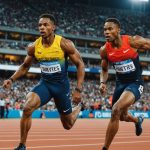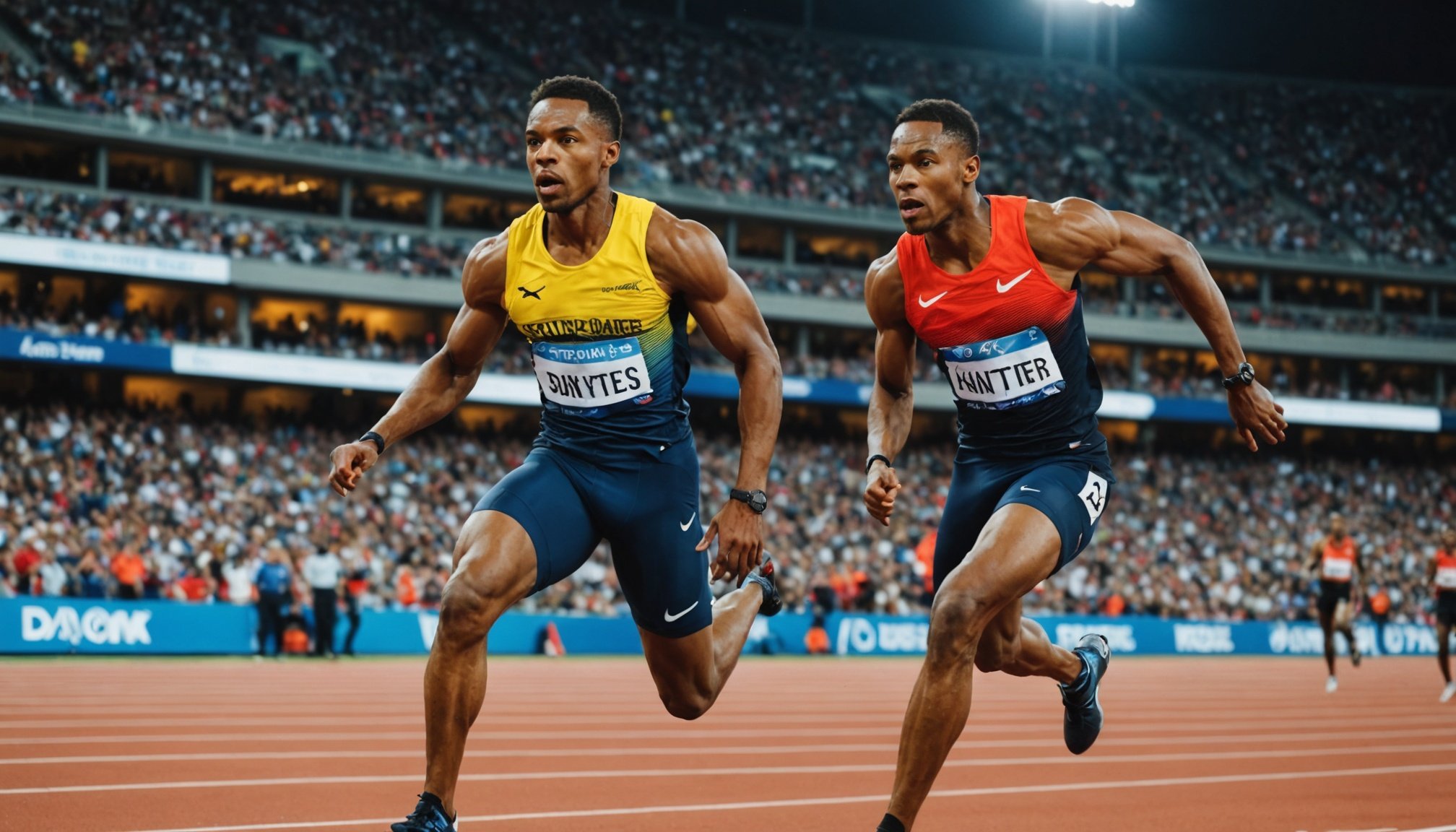Unlocking Speed: How Top Sprinters Utilize Performance Analytics to Boost Their Times
In the world of sprinting, every fraction of a second counts. Top sprinters are constantly seeking ways to optimize their performance, and one of the most powerful tools in their arsenal is performance analytics. This article delves into how data-driven insights are revolutionizing speed training, helping athletes to shave precious milliseconds off their times.
The Evolution of Performance Analytics in Sports
Performance analytics in sports is not a new concept, but its sophistication and impact have grown exponentially in recent years. Advanced technologies such as wearable devices, IoT sensors, and sophisticated software tools have made it possible to collect and analyze vast amounts of data on athletes’ movements, heart rates, muscle exertion, and more[2].
Also to see : Unlocking Performance: How Varied Paddles Enhance Biomechanics in Competitive Canoeing
In sprinting, this data is crucial for refining techniques, optimizing training regimens, and preventing injuries. Here’s how top sprinters are leveraging these tools:
Real-Time Data Collection
Modern sprint training often involves the use of timing gates, GPS trackers, and other wearable devices that provide real-time data on an athlete’s performance. For instance, sprinters can wear GPS-enabled vests that track their speed, distance covered, and even heart rate variability during training sessions. This real-time feedback allows coaches to make immediate adjustments to the training program, ensuring that the athlete is optimizing their speed and reducing the risk of injury[3].
This might interest you : Boosting Shooting Precision: Tips for Wheelchair Basketball Athletes to Enhance Their Accuracy
Tailoring Training Programs with Data Analytics
One of the key benefits of performance analytics is the ability to create highly individualized training programs. By analyzing data on an athlete’s biomechanics, coaches can identify specific areas that need improvement.
Narrow ISA vs. Wide ISA Athletes
Research in sprint training highlights the importance of understanding an athlete’s structural tendencies, often categorized into Narrow ISA (Intrinsic Stiffness Angle) and Wide ISA athletes. Narrow ISA athletes tend to have an elastic, spring-like movement quality, excelling in tempo sprints and plyometrics. In contrast, Wide ISA athletes rely on muscular force, benefiting from strength-based lifts and high-intensity sprints[4].
Training Recommendations for Different Athlete Types:
-
For Narrow ISA Athletes:
-
Focus on elasticity and rhythm through plyometrics and tempo sprints.
-
Reinforce linear movements with linear bounding and coordination exercises.
-
Keep strength training lighter and more dynamic to avoid diminishing elasticity.
-
For Wide ISA Athletes:
-
Prioritize strength exercises like squats and deadlifts to capitalize on their forceful tendencies.
-
Use high-intensity sprints with long recovery periods to enhance explosive power.
-
Incorporate lateral bounding and agility drills to support their natural stride width and lateral stability.
Analyzing Biomechanics for Optimal Performance
Motion capture technology has become a cornerstone in the analysis of athletes’ biomechanics. This technology allows coaches to assess every aspect of an athlete’s movement in real-time, making precise adjustments to optimize performance.
The Case of Usain Bolt
Usain Bolt, the world’s fastest man, is a prime example of how data-driven insights can lead to record-breaking performances. His coaches used sophisticated video analysis systems to assess his running form, optimizing his stride length and frequency. By meticulously studying his performance metrics, they identified critical adjustments that contributed to his unprecedented success, including setting the world record in the 100 meters with a time of 9.58 seconds in 2009[3].
Injury Prevention and Recovery
Injury prevention is a critical aspect of any athletic training program, and data analytics plays a pivotal role here. By tracking athletes’ muscle load, joint stress, and overall exertion during training and matches, coaches can identify when an athlete is at risk of injury and adjust the training load accordingly.
Real-Time Monitoring
In sports like football and cricket, GPS trackers and accelerometers are used to gather data on sprinting intensity, jump heights, and sudden stops. This information helps coaches manage workload, reducing the chances of hamstring strains or ligament tears. For example, the All India Football Federation (AIFF) has incorporated these technologies into their training programs to better manage player health[2].
Injury Prevention Strategies:
- Real-time Monitoring: Use GPS trackers and accelerometers to monitor athletes’ movements and exertion levels.
- Data-Driven Workload Management: Adjust training loads based on data to prevent overexertion.
- Customized Rehabilitation Programs: Use data to tailor rehabilitation programs, focusing on rebuilding specific muscle groups while monitoring healing progress in real-time.
Game Strategy and Tactical Insights
While the focus here is on individual sprint performance, data analytics also plays a significant role in team sports strategy. In sports like football and hockey, detailed data analysis provides insights into opponents’ strengths and weaknesses, allowing coaches to craft game plans that exploit these vulnerabilities.
Video Analytics in Football
In Indian football, coaches use video analytics to dissect the opposition’s defensive formations and identify patterns in their attacking play. This enables teams to create strategies that are both proactive and reactive to in-game situations. For instance, analyzing an opponent’s passing efficiency and defensive tactics can help a team prepare effective countermeasures[2].
Fan Engagement and the Future of Sports Analytics
The use of performance analytics is not only benefiting athletes but also enhancing fan engagement. Advanced analytics tools provide fans with deeper insights into the game, making it more engaging and interactive.
PlayerData App
Apps like PlayerData provide fans with real-time data on player performance, including speed, distance covered, and heart rate. This level of detail allows fans to appreciate the athleticism and strategy involved in the sport at a deeper level, fostering greater engagement and enthusiasm[2].
Practical Insights and Actionable Advice
For aspiring sprinters and coaches looking to integrate performance analytics into their training, here are some practical insights and actionable advice:
Start with Basic Metrics
- Timing Gates: Use timing gates to measure speed and acceleration.
- GPS Trackers: Track distance covered and heart rate variability.
- Video Analysis: Use video analysis to assess biomechanics and running form.
Invest in Advanced Technologies
- Motion Capture Technology: For detailed biomechanical analysis.
- Wearable Devices: To track muscle load, joint stress, and overall exertion.
- AI and Machine Learning: To predict performance trends and optimize training programs.
Focus on Individualized Training
- Understand Athlete Types: Tailor training programs based on Narrow ISA or Wide ISA tendencies.
- Real-Time Feedback: Use real-time data to make immediate adjustments to the training program.
Prioritize Injury Prevention
- Monitor Workload: Adjust training loads based on data to prevent overexertion.
- Customized Rehabilitation: Use data to tailor rehabilitation programs and monitor healing progress.
Performance analytics has transformed the landscape of sprint training, enabling athletes to achieve unprecedented speeds and performance levels. By leveraging real-time data, advanced technologies, and individualized training programs, top sprinters are unlocking new levels of speed and efficiency. As the field continues to evolve, it’s clear that data-driven insights will remain at the heart of athletic performance, driving innovation and excellence in the world of sports.
Table: Comparison of Training Methods for Narrow ISA and Wide ISA Athletes
| Training Aspect | Narrow ISA Athletes | Wide ISA Athletes |
|---|---|---|
| Focus | Elasticity and rhythm | Strength and power |
| Sprint Type | Tempo sprints | High-intensity sprints |
| Strength Training | Light and dynamic | Strength-based lifts |
| Agility Drills | Linear bounding and coordination | Lateral bounding and agility |
| Biomechanical Emphasis | Rotational strength and bounciness | Compact, powerful strides |
Quotes:
- “By meticulously studying his performance metrics, we identified critical adjustments that contributed to his unprecedented success.” – Usain Bolt’s Coach[3]
- “Data analytics has revolutionized how we approach game strategy and tactics. It allows us to craft game plans that exploit the vulnerabilities of our opponents.” – Indian Football Coach[2]
- “The use of performance analytics is not only benefiting athletes but also enhancing fan engagement. It provides fans with deeper insights into the game, making it more engaging and interactive.” – Sports Analyst[2]
Detailed Bullet Point List:
-
Real-Time Data Collection:
-
Use timing gates to measure speed and acceleration.
-
Employ GPS trackers to track distance covered and heart rate variability.
-
Utilize wearable devices to monitor muscle load, joint stress, and overall exertion.
-
Individualized Training Programs:
-
Tailor training based on Narrow ISA or Wide ISA tendencies.
-
Focus on elasticity and rhythm for Narrow ISA athletes.
-
Prioritize strength and power for Wide ISA athletes.
-
Injury Prevention Strategies:
-
Monitor workload using GPS trackers and accelerometers.
-
Adjust training loads based on data to prevent overexertion.
-
Use data to tailor rehabilitation programs and monitor healing progress.
-
Advanced Technologies:
-
Invest in motion capture technology for detailed biomechanical analysis.
-
Use AI and machine learning to predict performance trends and optimize training programs.
-
Utilize video analysis to assess running form and biomechanics.






